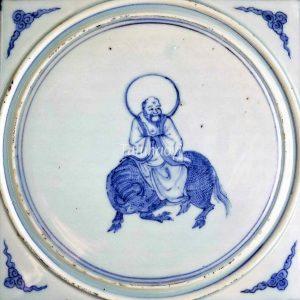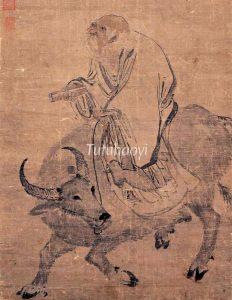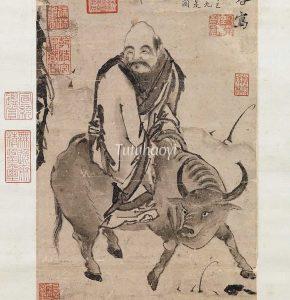Laozi Riding on a Black Buffalo
老子骑青牛
© Tutuhaoyi.com owns the copyright of the description content for the images attached. Quoting all or part of the description content on this page is permitted ONLY IF ‘Tutuhaoyi.com’ is clearly acknowledged anywhere your quote is produced unless stated otherwise. (本页描述内容版权归Tutuhaoyi.com所有,转发或引用需注明 “Tutuhaoyi.com”, 侵权必究, 已注开源信息的条目除外。)
Laozi (Lao Tzu 老子), literally ‘old teacher or master’, is the well-known name for a great ancient Chinese thinker, to whom a five-thousand-character book ‘Dao de jing 道德经’, or The Scripture of the Way and Virtue, has been attributed. He is regarded as the founder of philosophical Daoism (Taoism), daojia 道家, because of his profound insights to life and the world, and a supreme deity in religious Daoism (Taoism), daojiao 道教, and popular Chinese religious cults.
The earliest images of the legendary figure can be traced back to the Ming dynasty (1368 – 1644) when he was typically portrayed as a geriatric riding on the signature buffalo, as are found on two hanging scrolls, one by the Zhe-school painter Zhang Lu 张路 (ca. 1464 – 1538) and the other spuriously attributed to Chao Buzhi 晁补之 (1053 – 1110), a Song-dynasty literary man. In the former, Laozi is holding a scroll in his right hand, presumably representing his seminal work. In the latter, Laozi is depicted as a stout character, which later became Laozi’s more formal persona.
Read more about Laozi’s famous events here.
Fig 1-2: blue-and-white tile with Laozi riding on a buffalo, Wanli period (1573-1620), Ming dynasty, courtesy of the British Museum, London
Fig 3-4: Laozi riding on a buffalo, light ink and colour on paper, Zhang Lu (ca.1464-1538), Ming dynasty (1368-1644), courtesy of the National Palace Museum, Taipei
Fig 5-6: Laozi riding on a buffalo, hanging scroll, ink on paper, Chao Buzhi (1053-1110), courtesy of the National Palace Museum, Taipei





